

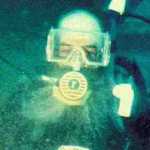 Rev. Mad Jack has been a well known figure in the body modification
community for some time now, most recently as the owner of Body
Basics in Chicago. They are located at 613 West Briar, Chicago,
(312)404-5838, and can be reached via email at
[email protected],
or via their web page. The
following interview was conducted via email in Sepember - October of
1996. Images were supplied by Body Basics, and can also be seen on their
web page.
Rev. Mad Jack has been a well known figure in the body modification
community for some time now, most recently as the owner of Body
Basics in Chicago. They are located at 613 West Briar, Chicago,
(312)404-5838, and can be reached via email at
[email protected],
or via their web page. The
following interview was conducted via email in Sepember - October of
1996. Images were supplied by Body Basics, and can also be seen on their
web page.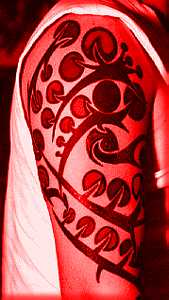 BME: How did you first become interested in body modification, on a personal
rather than professional level?
BME: How did you first become interested in body modification, on a personal
rather than professional level?Jack: I first became interested in body modification in general when I was a young teenager. I lived with my very straight laced parents in a suburban community at that point. Before that we lived in the inner city, and out in the suburbs I was somewhat of a rebel?!
So was your piercing public or private then?
At that point in time my piercing was kept very private. Keep in mind we are talking back in the 1960s.
Were you on your own doing it, as an individual, or were you in a peer-group where it was acceptable?
I was very much on my own doing it, my peer group would never have been able to deal with it.
So you were piercing on yourself? Where did you find things like jewelry?
Yes, it was on myself. As for jewellery, well, as with anything that is desired bad enough, one finds ways. I would search out jewellery that would work and do whatever was within my ability to modify it. I was usually pretty creative and figured out what was needed fairly quick.
At this point I worked whatever type of job I could. Mainly construction work as it paid well and nobody seemed to care wha I looked like.
 And how did those interests become a career?
And how did those interests become a career?
My interests started to become the dream of a like in the body modification arts when I was about 17 yrs old, during the experience of getting my first professionally done tattoo. I knew when that needle touched my skin what my calling was for life. I sought knowledge about any and all body modification from that point on.
Did you start as a tattoo artist, or as a piercer?
I began my professional career as a tattooist, then a short time later began really learning piercing, and added the piercing to my work.
And how did your professional history continue from there?
My professional history would require thanks to many people from over the years, from many walks of life. I've had instruction and some simple pointers from some of the all time great's, as well as some no name nobodies who would prefer to remain unknown. I always say I quit counting how long I've been in the business after 15 years because it makes me feel old. Well for the world to figure out, I turn 44 years old in October of '96 and I've been learning and actively working in the body modification arts since shortly after I got my first professional tattoo. When I close my mind to learning I'll be dead and gone so I have a long time to go before I know everything there is for me to absorb out there.
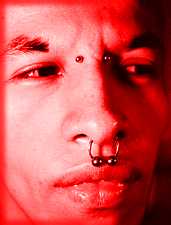 What is it that differentiates a bad artist from a good artist from
a great artist (in all the body arts)?
What is it that differentiates a bad artist from a good artist from
a great artist (in all the body arts)?
Working clean, caring about the quality of your work, taking the time to learn what you are doing before attempting to do it, ethics, honesty, caring about the people whom you work on, giving to the body arts and not just taking from them.
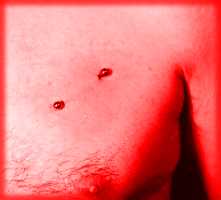 One of the things that you've become known for is surface-piercings.
Could you tell us a bit about how that came about, and what your feelings
on them are, especially in light of the attention that extreme piercings
have been getting lately?
One of the things that you've become known for is surface-piercings.
Could you tell us a bit about how that came about, and what your feelings
on them are, especially in light of the attention that extreme piercings
have been getting lately?
I'm not really quite sure how it came about that I became known for surface piercing. I do know that I've achieved a very high success rate of healed healthy surface to surface piercing. Some of that comes from the technique I use to do the piercing, some comes from the detailed aftercare and follow-up care I give.
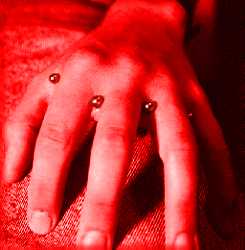 Does different care need to be given to surface piercings than to "normal"
piercings?
Does different care need to be given to surface piercings than to "normal"
piercings?
Basicly the only difference would be follow up care done by us in he shop to try and help people with problematic piercings, but that is ALL problematic piercings, not just surface piercings. I truly believe most of my success in that area comes from the simple fact that I really care and am willing to give my all, from the first time I talk to someone about what they want to subsequent visits through follow-up care. The attention that the "extreme piercing" have been getting recently, which has not all been good, can be viewed as public concern for what is not yet fully understood by the masses. I don't always agree with all the things I see being done, but who are we to question what other people want done with their bodies. I am by no means condoning everything that goes on in the body modification world, in fact quite the contrary, I have very definite opinions on a lot of things I see. I am however old enough and wise enough to keep my opinions to myself, unless something is so far out of hand that there is obvious danger to the individual.
Do you see the APP or APT playing a role in any of this?
No, I don't. I've sugested an ethics committee, but nobody seems to feel it is a can of worms they want any part of.
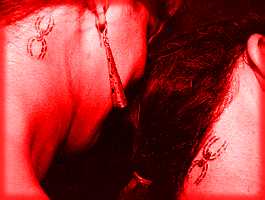 How have you seen the industry change while you've been in it?
How have you seen the industry change while you've been in it?I've seen lots of changes, some good, some not so good. The main changes I've seen have been the advance of people learning to work clean. Some of them anyway. I've seen a lot more acceptance from the general public. Of course I've also seen an awful lot of people jump on the bandwagon, wanting to cash in on the popularity, yet not know what they are doing. VERY SCARY!!!
Where do you see the industry going over the next few years, and how do you see your role in it?
The industry will continue to grow as more and more people learn about
it. With the advent of more peopple becoming directly involved we will see
tattoos that are so fine they should be in museums. Piercings will continue
to become more openly accepted until they are as well accepted as simple ear
piercings are now, with constantly improved aftercare.
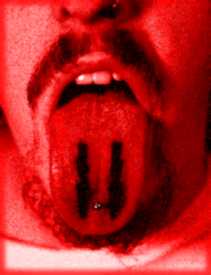 The Tongue Tattoo
The Tongue TattooWas that done using a machine, or some other method? What was it like -- A lot of spreading? What design options are there for tattooing a tongue? How did it heal?
Yes, it was done with a tattoo machine. With the tattooed tongue is a
somewhat tricky situation. Very few design options will work due to the
moistness and general area. There can be a lot of spreading, if someone
works deep. As for healing, well, the tongue heals so very quick that there's
not much one can really do. With the tongue, one must realize that most of
the ink will end up falling out and only a light design will remain. The
actual process of the tattoo is extremely tricky, as it is a possible needle
stick injury waiting to happen.
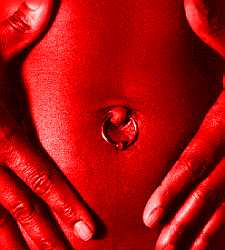 The "Outie" Navel
The "Outie" NavelSome people have claimed that this is a dangerous piercing. Michaela Grey of the APP has even gone as far as to say it carries with it a risk of liver infection... How did you assess the risks of this piercing, and determine that it was safe to do?
The outie navel is no more dangerous than any other piercing. The so called direct link to the "liver"(?) -- well, let's stop and consider other piercings for a moment. The septum is linked to the brain supposedly, as well as the nostril. Then there's the tongue... and let's not ignore the dangers of various genital piercing, the PA, the Clitoris, the Triangle, then last but not least what about the dangers of the Uvula.
I assess the risks of all piercings with an exam of the persons tissue, and
a private discussion with the person so that they are aware of what is
involved. I also explain to the person that we do follow up care so if they
have any problems, we are there to help them through the problem. Not every
piercing is right for every person and if it looks though it may not work
out for the individual they are made aware of the situation. We also have
doctors that are piercing friendly that we can refer people to if it gets to
that point.
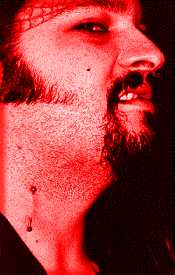 The Neck Piercing
The Neck PiercingAgain, these are piercings that some piercers claim are too dangerous to attempt. What sort of checking is done to make sure the client is at no risk?
The same answer applies to this question that I gave to the "Outie Navel". With a neck pierce what one is dealing with is a surface pierce, and at best there is a 50/50 initial chance it will heal successfully. Sometimes we have to do repeated follow-up/check-up appointments with surface to surface piercing.
I do not like to lose a piercing, and will work with people to try and not
let a lost piercing happen. Most people who get these types of piercings are
willing to deal with the trials and tribulations that come with the
territory.
Do
|
Do Not
|
DO's
|
DO NOT's
|
ENJOY YOUR NEW WORK OF SKIN ART!!!! If you have doubts or questions, by all means call!